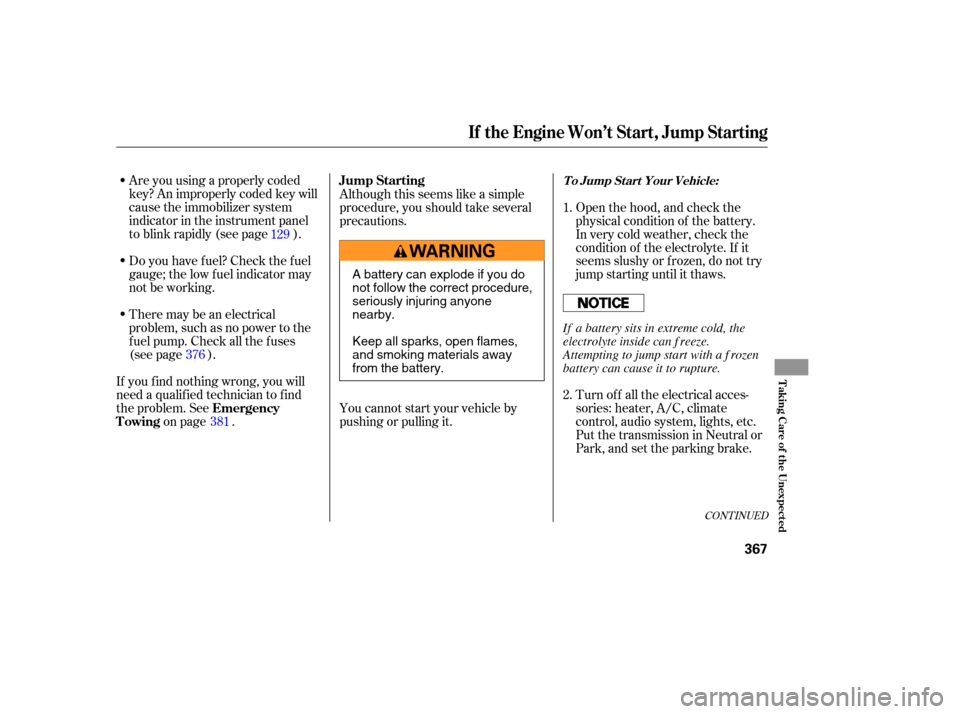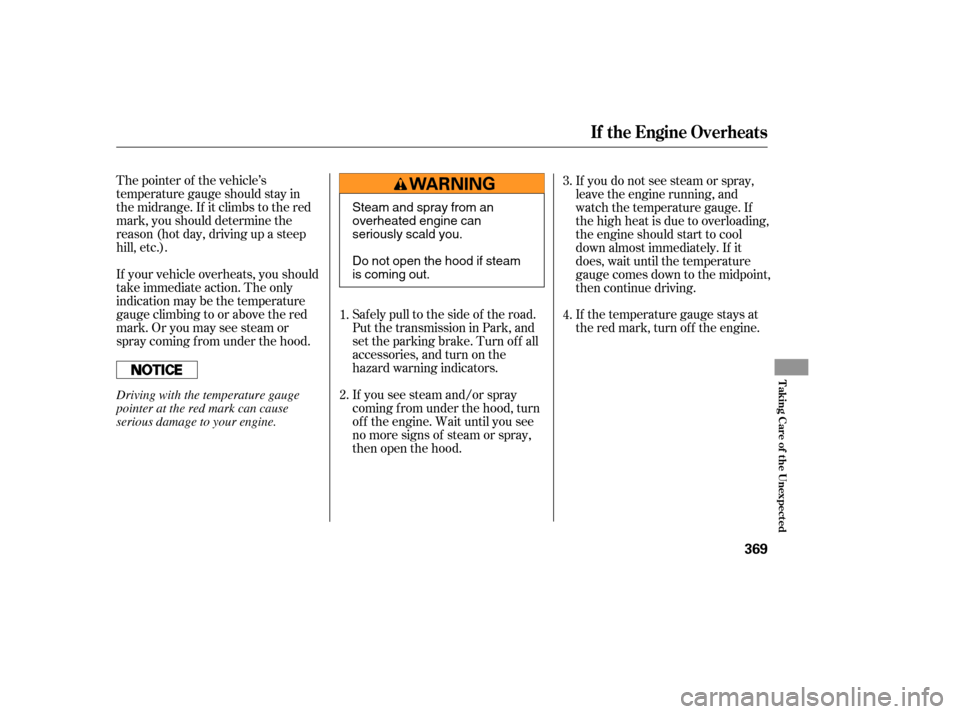Page 368 of 414

Are you using a properly coded
key? An improperly coded key will
cause the immobilizer system
indicator in the instrument panel
to blink rapidly (see page ).
Do you have f uel? Check the f uel
gauge; the low f uel indicator may
not be working.
There may be an electrical
problem, such as no power to the
f uel pump. Check all the f uses
(see page ).
If youfindnothingwrong,youwill
need a qualif ied technician to f ind
the problem. See on page . Although this seems like a simple
procedure, you should take several
precautions.
Open the hood, and check the
physical condition of the battery.
In very cold weather, check the
condition of the electrolyte. If it
seems slushy or f rozen, do not try
jump starting until it thaws.
You cannot start your vehicle by
pushing or pulling it. Turn of f all the electrical acces-
sories: heater, A/C, climate
control, audio system, lights, etc.
Put the transmission in Neutral or
Park, and set the parking brake.
1.
2.
376
381 129
CONT INUED
Emergency
Towing Jump Starting
To Jump Start Your Vehicle:
If the Engine Won’t Start, Jump Starting
T aking Care of t he Unexpect ed
367
A battery can explode if you do
not follow the correct procedure,
seriously injuring anyone
nearby.
Keep all sparks, open flames,
and smoking materials away
from the battery.
If a battery sits in extreme cold, the
electrolyte inside can f reeze.
Attempting to jump start with a f rozen
battery can cause it to rupture.
Page 370 of 414

The pointer of the vehicle’s
temperature gauge should stay in
the midrange. If it climbs to the red
mark, you should determine the
reason (hot day, driving up a steep
hill, etc.).
If your vehicle overheats, you should
take immediate action. The only
indication may be the temperature
gauge climbing to or above the red
mark. Or you may see steam or
spray coming f rom under the hood.If you see steam and/or spray
coming f rom under the hood, turn
of f the engine. Wait until you see
no more signs of steam or spray,
then open the hood.If you do not see steam or spray,
leave the engine running, and
watch the temperature gauge. If
the high heat is due to overloading,
the engine should start to cool
down almost immediately. If it
does, wait until the temperature
gauge comes down to the midpoint,
then continue driving.
If the temperature gauge stays at
the red mark, turn off the engine.
Saf ely pull to the side of the road.
Put the transmission in Park, and
set the parking brake. Turn of f all
accessories, and turn on the
hazard warning indicators.
1.
2. 3.
4.
If theEngineOverheats
T aking Care of t he Unexpect ed
369
Steam and spray from an
overheated engine can
seriously scald you.
Do not open the hood if steam
is coming out.
Driving with the temperature gauge
pointer at the red mark can cause
serious damage to your engine.
Page 372 of 414

Saf ely pull of f the road, and shut
of f the engine. Turn on the hazard
warning indicators.
Let the vehicle sit f or a minute.
Open the hood, and check the oil
level (see page ). An engine
very low on oil can lose pressure
during cornering and other driving
maneuvers.
If necessary, add oil to bring the
level back to the full mark on the
dipstick (see page ).
Start the engine, and watch the oil
pressure indicator. If it does not go
out within 10 seconds, turn of f the
engine. There is a mechanical
problem that needs to be repaired
bef ore you can continue driving
(seeon page
).
You will also see a ‘‘CHECK
ENGINE OIL LEVEL’’ message in
the multi-information display when
this indicator comes on. This indicator should never
come on when the engine is
running. If it starts f lashing or stays
on, the oil pressure has dropped very
low or lost pressure. Serious engine
damage is possible and you should
take immediate action.
You will also see a ‘‘CHECK
CHARGING SYSTEM’’ message in
the multi-information display when
this indicator comes on. Go to a service station or garage
where you can get technical
assistance. Immediately turn of f all electrical
accessories. Try not to use other
electrically operated controls such as
the power windows. Keep the engine
running; starting the engine will
discharge the battery rapidly.If the charging system
indicator comes on brightly
when the engine is running, the
battery is not being charged.
1.
2.
3.
4. 281
328
381
On Touring model On Touring model
L ow Oil Pressure Indicator
Emergency T owingCharging System Indicator
L ow Oil Pressure Indicator, Charging System Indicator
T aking Care of t he Unexpect ed
371
Running the engine with low oil
pressure can cause serious mechanical
damage almost immediately. Turn of f
the engine as soon as you can saf ely get
the vehicle stopped.
Page 376 of 414
The vehicle’s f uses are contained in
f our f use boxes (three, if the vehicle
does not have a rear entertainment
system).To open the passenger’s f use box,
pull the right edge of the cover.
Theinteriorfuseboxesarelocated
under the dashboard on the driver’s
and passenger’s side. The primary under-hood f use box is
on the passenger’s side. To open it,
pushthetabsasshown.
The secondary under-hood f use box
is behind the primary f use box.
Fuses
T aking Care of t he Unexpect ed
375
DRIVER’S SIDE INTERIOR
PASSENGER’S SIDE
INTERIORPRIMARY UNDER-HOOD FUSE BOX
SECONDARY UNDER-HOOD FUSE BOX
Page 407 of 414

Fluids..........
Automatic Transmission . 334
..........................................
Brake .335
..........................
Power Steering .336
................
Windshield Washers . 121
FM Stereo Radio ...................................
Reception .205
.................
Folding the Third Seat . 158
........................
Four-way Flashers .126
............................
Front Airbags .11, 27
......................................
Front Seat .148
....................................
Adjusting .149
.......................................
Heaters .160
...................................
Airbags .11, 27
.................................................
Fuel .278
......................
Fill Door and Cap .279
...........................................
Gauge .71
................
Octane Requirement . 278
....................................
Ref ueling .279
........................
Reserve Indicator .68
.....................
Fuses, Checking the .376
...............
Gas Mileage, Improving . 283.........................................
Gasoline .278
...............
Fuel Reserve Indicator . 68
...........................................
Gauge .71
................
Octane Requirement . 278
....................................
Ref ueling .279
................
Gas Station Procedures . 279
Gauges ...
Engine Coolant Temperature . 71
...............................................
Fuel .71
...............................
Speedometer .71
.................................
Tachometer .71
GAWR (Gross Axle Weight .......................................
Rating) .307
GCWR (Gross Combined Weight .......................................
Rating) .307
......................................
Glove Box .180
GVWR (Gross Vehicle Weight .......................................
Rating) .307
.............
Halogen Headlight Bulbs . 337
............
Hazard Warning Flashers . 126
.....................................
Headlights .122
........................................
Aiming .337
............
Automatic Lighting Off . 124 .........
Daytime Running Lights . 125
..................
High Beam Indicator . 69
.......................
Reminder Chime .122
........
Replacing Halogen Bulbs . 337
.................................
Turning on .122
...................................
Headphones .260
............................
Head Restraints .152
...............................
Heated Mirror .168
...................................
Heater, Seat .160
.....................
Heating and Cooling .188
.............
High Altitude, Starting at . 293
...............
High-Low Beam Switch . 122
HomeLink Universal ................................
Transceiver .267
.......................
Hood, Opening the .280
...........................................
Horn .5,120
...
Identif ication Number, Vehicle . 384
Ignition ............................................
Keys .128
.........................................
Switch .130
............
Timing Control System . 393
......................
Immobilizer System .129
.........
Important Safety Precautions . 8
Index
H I
G
IV